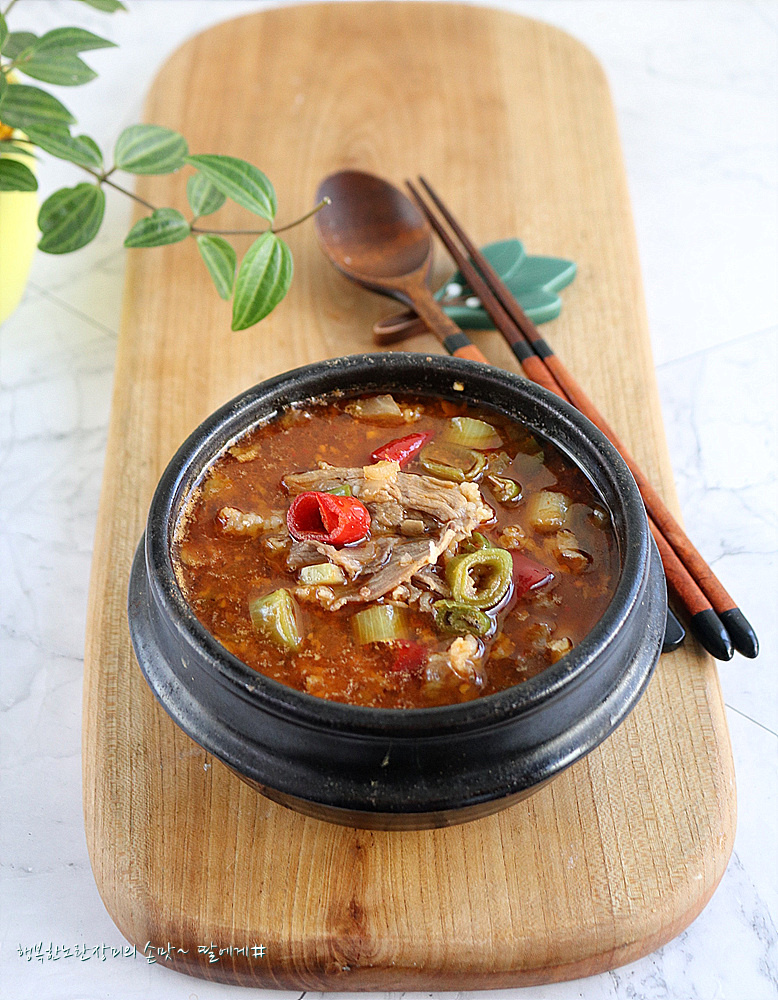Rich and Hearty Beef Brisket Doenjang Jjigae (Korean Soybean Paste Stew)
Gourmet Restaurant Taste at Home! How to Make Beef Brisket Doenjang Jjigae (feat. Beef Brisket Shabu-Shabu)

Experience the deep, savory flavor of Beef Brisket Doenjang Jjigae that rivals that of any restaurant! Packed with tender beef brisket, this stew offers a harmonious blend of rich broth and succulent meat, all made conveniently at home. The flavor deepens with every simmer, and for an extra special touch, enjoy it as a delightful beef brisket shabu-shabu right at your table.
Ingredients- Generous amount of beef brisket (fresh is better than frozen)
- 3 Tbsp Doenjang (Korean soybean paste)
- 2 Tbsp Sesame oil
- 1/2 Tbsp Gochujang (Korean chili paste) (optional)
- 1/2 Onion
- 1/4 Radish (or a 2cm thick slice)
- 1/2 Green onion stalk
- 2 Korean green chili peppers
- 1 Red chili pepper
- 1/2 Tbsp Tuna extract or Korean soup soy sauce
- 1/2 Tbsp Fish sauce or Korean soup soy sauce
Cooking Instructions
Step 1
First, prepare the beef brisket. While frozen brisket can be used, fresh brisket will yield a richer flavor. Be sure to have a generous amount, especially if you plan to enjoy it as shabu-shabu later. Slice the brisket for stir-frying into bite-sized pieces (chopped roughly).

Step 2
Place a ttukbaegi (earthenware pot) over medium-high heat and add 2 tablespoons of sesame oil. Once hot, add the prepared beef brisket and 3 tablespoons of doenjang. If using homemade doenjang, it’s best to use a less salty variety. If your doenjang is quite salty, consider mixing it with store-bought doenjang or simply adjusting the quantity.

Step 3
Reduce the heat to medium-low and stir-fry the beef brisket and doenjang until fragrant. The sesame oil and the rendered fat from the brisket will combine, releasing a wonderfully savory aroma. This step significantly deepens the umami flavor of the doenjang.

Step 4
Pour water into the pot with the stir-fried brisket and doenjang, and bring to a boil over high heat. You might notice some foam forming initially, which is a natural combination of sesame oil and brisket fat. Don’t worry about skimming it off just yet.

Step 5
Next, prepare the vegetables. Dice the onion and radish into small cubes or slice them thinly. Slice the green onion and chili peppers diagonally. You can also add mushrooms or tofu if you like, but since the brisket is the star, feel free to use any leftover vegetables you have on hand.

Step 6
Once the broth is boiling, add the prepared radish, onion, green onion, and green chili peppers. Continue to boil. For a visually appealing touch, add the sliced red chili pepper as well – it makes the stew look even more appetizing!

Step 7
Add minced garlic and a little gochujang to enhance the stew’s flavor complexity. Season the stew with tuna extract or fish sauce (or both, mixed together, as I did) to taste, adjusting based on the saltiness of your doenjang.

Step 8
Now, add a generous amount of beef brisket and let it simmer vigorously over high heat. You can add a pinch of red pepper powder if you prefer a spicier kick. Let it cook for a few more minutes until all the ingredients are well combined. Serve the stew hot, directly in the ttukbaegi.

Step 9
As you eat at the table, add more beef brisket to the simmering stew and enjoy it shabu-shabu style. The savory oils from the brisket will meld beautifully with the doenjang, creating a rich, deep flavor without being greasy.

Step 10
Beef Brisket Doenjang Jjigae is best enjoyed piping hot. The brisket fat can solidify as it cools, so it’s highly recommended to keep the ttukbaegi on the table over a low heat source and continue simmering as you eat.




